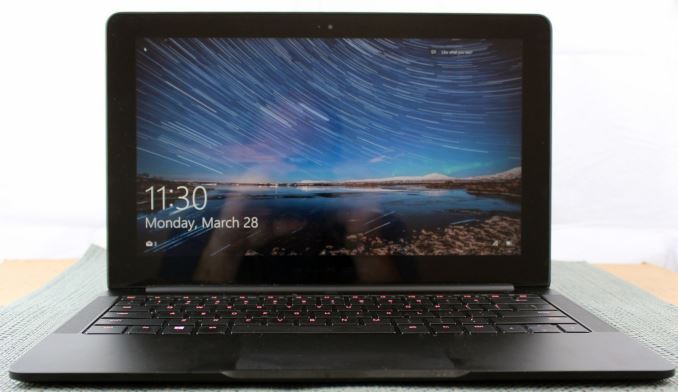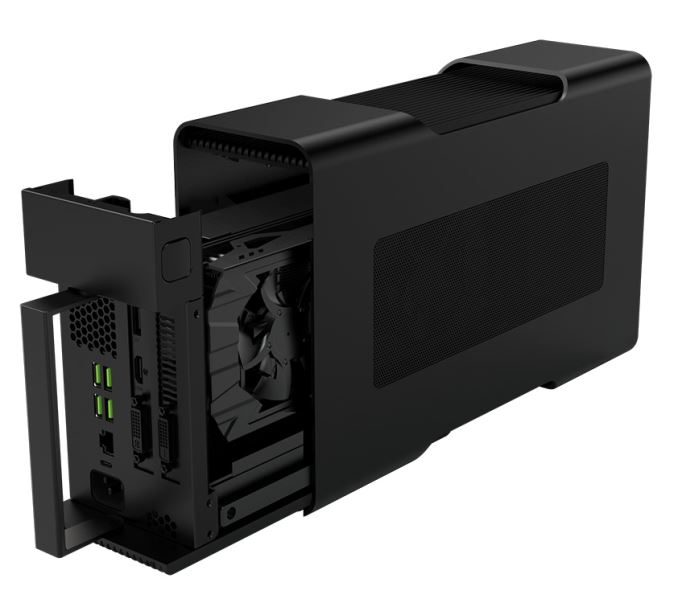The Razer Blade Stealth Review: Razer Takes On The Ultrabook
by Brett Howse on March 29, 2016 8:00 AM EST- Posted in
- Laptops
- Razer
- Skylake
- Razer Blade Stealth
- eGFX
- Razer Core
- Skylake-U

Razer has traditionally been a company focused on gaming. In fact, their tagline is “For Gamers. By Gamers.” So when Razer announced at CES that they were building an Ultrabook – a product category whose size and power limitations are typically the antithesis of gaming – it was a bit surprising. Razer decided it was time to branch out into more of the mainstream of PC hardware, but of course with the Razer twists they are known for. The Razer Blade Stealth is not your typical Ultrabook, and one of the biggest twists of all is that it can be docked to a desktop GPU to actually enable gaming.
The Razer Blade Stealth is a stand-alone product, so we can’t assume everyone that buys it will purchase the first Thunderbolt 3 external graphics dock which Razer developed for it, but the Razer Core is certainly an interesting addition to the notebook. We’ll take a closer look at that in the future, but for now the Razer Blade Stealth must be a capable device on its own merits.
When you talk about value, it doesn’t mean low cost. The Razer Blade Stealth is not an inexpensive notebook, but when you look at what kind of technology is inside, the value proposition starts to have some merit. Razer, has traditionally offered the high quality Razer Blade 14, but it was never as inexpensive as the competition. With the Razer Blade Stealth, as well as the new pricing on the Razer Blade 14, the company appears to want to reach a much wider audience.
The 12.5-inch Razer Blade Stealth (which for the sake of brevity I'll refer to as simply the Stealth) starts at $999, which makes it one of the most inexpensive Ultrabooks available with a Core i7 processor. There are not different models with Core i3/i5/i7, but instead every Stealth ships with a Core i7-6500U. The Dell XPS 13, as an example, only offers the i7 on the most expensive models, which are over $600 more expensive. Instead of processor based models, Razer is segmenting their models by offering two different displays: a base offering with a sRGB QHD 2560x1440 panel, and a higher-end model with an Adobe RGB UHD 3840x2160 panel. There are also three storage offerings, with 128 GB and 256 GB available on the QHD model, and 256 GB and 512 GB on the UHD version. All storage is provided by Samsung’s PM951, which is a PCIe 3.0 x4 NVMe drive with TLC NAND.
| Razer Blade Stealth | |||||
| QHD | UHD (As Tested) | ||||
| CPU | Intel Core i7-6500U Dual-Core with Hyperthreading 2.5-3.1 GHz, 4MB Cache, 15W TDP |
||||
| GPU | Intel HD 520 300-1050MHz, 24 Eus |
||||
| Memory | 8GB LPDDR3-1866 Dual-channel | ||||
| Display | 12.5-inch IGZO 2560x1440 sRGB with touch |
12.5-inch IGZO 3840x2160 Adobe RGB with touch |
|||
| Storage | 128-256GB PCIe NVMe Samsung PM951 |
256-512GB PCIe NVMe Samsung PM951 |
|||
| I/O | USB 3.1 Type-C x 1 with Thunderbolt 3 USB 3.0 Type-A x 2 Headset jack 2.0MP Webcam HDMI |
||||
| Dimensions | 321 x 206 x 13.1 mm 12.6 x 8.1 x 0.52 inches |
||||
| Weight | 1.25 kg / 2.75 lbs | ||||
| Battery | 45 Wh, 45 W AC Adapter (USB-C) | ||||
| Keyboard | Chroma anti-ghosting keyboard with individually backlit keys | ||||
| Wireless | Killer 1535 802.11ac 2x2:2 with Bluetooth 4.1 |
||||
| Price | $999.99-$1199.99 | $1399.99-$1599.99 | |||
Looking at the rest of the product, we can see that Razer has decided to move to Killer’s networking solution, which fits in more with their gaming aspect, but the latest Killer products have been reliable in my experience too, so I think this is not a bad move. Razer offers a single Thunderbolt 3 port over USB-C, which doubles as the charging port for the laptop. When docked to the Razer Core, this is a single cable docking solution which does the external graphics and I/O as well as laptop charging. In addition, there are two USB 3.0 ports on the laptop, along with an HDMI port, but there is no SD card reader.
The 8 GB of memory is really the minimum that would be acceptable in a 2016 Ultrabook, and there’s no option for more memory which is unfortunate. But other than that, Razer offers quite a bit of notebook for the $999 starting price. Though personally I suspect that $1199 is going to be the sweet spot, as it offers 256 GB of storage and the QHD display.











66 Comments
View All Comments
nerd1 - Tuesday, March 29, 2016 - link
Xps13 can be bought around 799 nowadaysBrokenCrayons - Tuesday, March 29, 2016 - link
“For Gamers. By Gamers.”Interplay, is that you in there? What happened to Van Buren?
retrospooty - Tuesday, March 29, 2016 - link
I never really got the need for a "gaming notebook". Gaming is far better, faster and cheaper on a desktop. Do alot of people really have the need to game when mobile? I would personally think most people, when out and about are doing whatever task they are out and about for, not worrying about gaming until they get home and have time for it. Is it just me? I guess if you travelled for work alot and wound up with extra time, but that screams niche market.BrokenCrayons - Tuesday, March 29, 2016 - link
Most mobile gaming I see happens on a phone and not on a laptop. There are most certainly a lot of people who spend time away from home due to work that might benefit from a gaming laptop, but this particular laptop isn't a gaming box without the not-so-mobile Razer Core and other external bits like a monitor, full sized keyboard, and mouse. The benefit in this to those sorts of people is that they only need to worry about one computer as opposed to a laptop and desktop. The Stealth's potential of using an external, desktop GPU offers some flexibility at an added cost. So yes, there's a point and yes its a niche market.The "but" in all of this is that the niche market might be larger than you think. People with no legitimate need for the capabilities the Stealth + Razer Core offers might still purchase such a setup or some other gaming laptop in order to have those capabilities. The expense could very well do nothing but address a psychological need that exists without reason purely inside the mind of the buyer. It happens pretty frequently in automotive markets where people buy much more capability than they need in order to be prepared to drive in weather or road conditions that happen for merely a day or two out of the year. They then willingly endure the liability of their purchase the other 363 days happily. Similarly a person with no need for a gaming laptop will be able to play games in a hotel room for a couple of days a year and deal with the cost and performance penalty of their purchase the rest of the time for little to no rational reason.
TheinsanegamerN - Tuesday, March 29, 2016 - link
There are people like me, that have LAN gaming parties. A laptop is so much more convenient. And I can play it at the laundromat when Im doing my laundry every weekend.I also live in a 1BD apartment. Space is at a premium, there is nowhere to put a nice computer desk for a desktop.
nerd1 - Tuesday, March 29, 2016 - link
Laptop is more convenient but you cannot play any real game on this laptop.BrokenCrayons - Wednesday, March 30, 2016 - link
I never understood what makes something "real" or not. Even a nearly ten year old GMA 950 can run games, some of which were flagship releases in the past. Does the age of a game make it lose it's connection with reality? Is something only "real" if it's been released in the last few months because humans can't fathom the relationship of the past to the present?DarkXale - Wednesday, April 6, 2016 - link
Depends on the definition of real.CS? It can handle.
LoL? It can handle.
DOTA2? It can handle. (Even benchmarked here at +60FPS)
WoW? It can handle.
Civilization 5/BE? It can handle.
Football Manager? It can handle.
Rocket League? It can handle.
You'd probably want to stay clear of Battlefield 4 or Witcher 3 - but at this point we're talking exceptions, not a norm.
DarkXale - Wednesday, April 6, 2016 - link
I should point out that I chose these titles since they're generally where you tend to see the most /played being done -today-.rxzlmn - Tuesday, March 29, 2016 - link
I don't think it's that uncommon for people to have jobs which require a decent amount of travelling. The main point is that it's easily transported from A to B, not that you can use it for gaming on the route itself. If you move, especially internationally, it makes sense. If you don't have a lot of space, it makes sense. If you want to have one main computer for both work and gaming, it makes sense (as a computer for work often has to be portable, i.e. bringing it to work places, meetings, on the plane, etc).I have a solid notebook that also happens to be powerful enough to run games, and nowadays the mobile GPU/CPUs are fast enough to run most games properly. Of course not with all the bells and whistles, but I can play most stuff on full HD and somewhat medium settings just fine, and my laptop only has a midrange mobile GPU.
Apart from myself opting for all the above mentioned benefits, I would also have to spend considerably more for a gaming capable desktop and a comparable non-gaming capable laptop together.